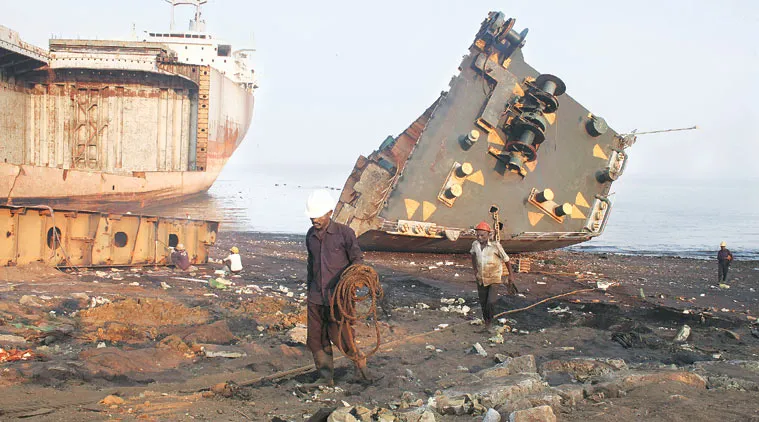 |
The beach at Alang has been carved out into 167 plots or breaking yards
of various sizes, of which 131 have been allotted to ship-breaking firms.
|
For years, ageing liners and cruise ships have queued up at Alang, where
they would be dismantled and sold for scrap. That’s changing.
Not everyone has a window by the sea. Kiran Gandhi has one so he looks
out every few minutes at the waves crashing into the beach and says it wasn’t
always this way. “Until a few years ago, it was difficult to spot the beach or
the sea.
It used to be full of ships,” he says, sipping tea at the office of Shree
Ram Group of Industries, a shipbreaking firm in Alang. Gandhi, one of the
directors of the firm, looks on as labourers armed with gas torches and sledge
hammers cut down a lone ship beached in his yard No 9. “By this time last year,
we had broken six ships. This year, we are only breaking the third one,” he
says.
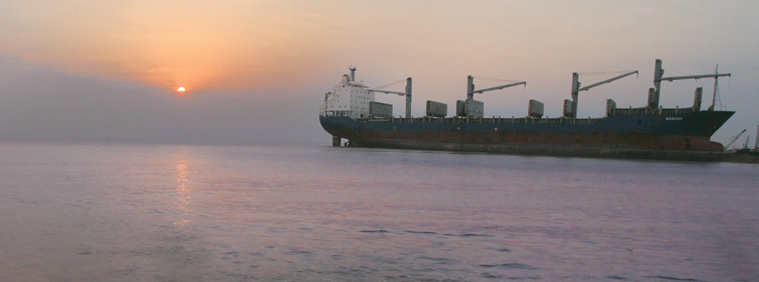
The unhindered view of the sea and the sun on the horizon are signs that
all is not well at Alang, considered the world’s largest graveyard of ships.
Not too long ago, this 10-kilometre stretch along the coast of Alang, a town in
Bhavnagar district of Gujarat, used to be lined up with old and decommissioned
ships. These were ships that once rode the high seas, but past their prime,
they end up on the shores of Alang, where workers with blowtorches and hammers
strip it of steel and other accessories. But now, the oil-soaked beach looks
almost barren, with only a few ships dotting the horizon, their rusted anchors
and chains the only reminders of a beach that once brought down hulks.
Alang, with a capacity to dismantle 450 ships annually, handled 415 ships
in 2011-12. That’s the highest number of vessels to have beached since 1983,
when the first vessel, MV Kota Tenjong, arrived in Alang to be dismantled. The
number of ships docking at Alang has steadily fallen since then and last year,
it touched 275, a six-year low. Between April to September this year, only 97
ships have arrived; 157 ships arrived in the same period last year.
The beach at Alang has been carved out into 167 plots or breaking yards
of various sizes, of which 131 have been allotted to ship-breaking firms. Over
70 per cent of these 167 plots, where over 6,900 old ships have been broken and
recycled in the last three decades, have either shut down or have run out of
business. The 40 plots that remain open operate with a third of the 20,000
workforce that once used to power this labour-intensive shipbreaking yard.
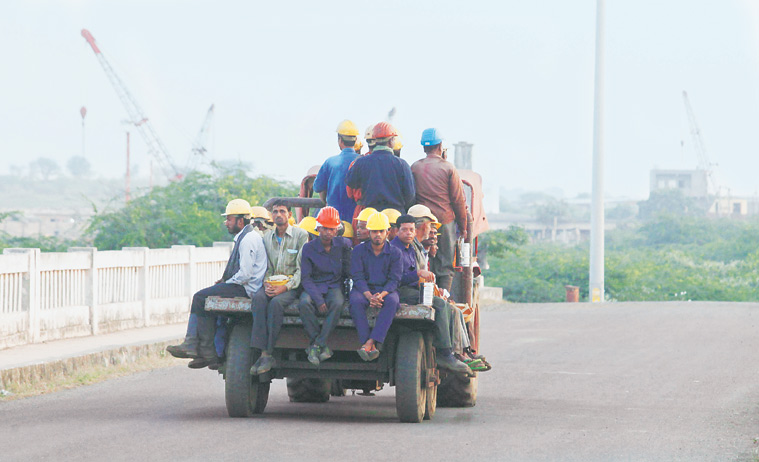
“The plots have been closing down as the owners have stopped buying
ships. It’s just becoming unviable,” says Captain Sudhir Chadha, a port officer
from the Gujarat Maritime Board (GMB) and one of the seniormost state
government representatives at Alang.
So why aren’t more ships docking at Alang? The combined pressure of cheap
Chinese steel making its way into India, devaluation of the rupee and the
slowdown in the infrastructure sector seem to be taking their toll on the
business at Alang, where 70 per cent of a ship is broken down into re-rollable
scrap than that’s then converted into bars and rods for the construction
sector.
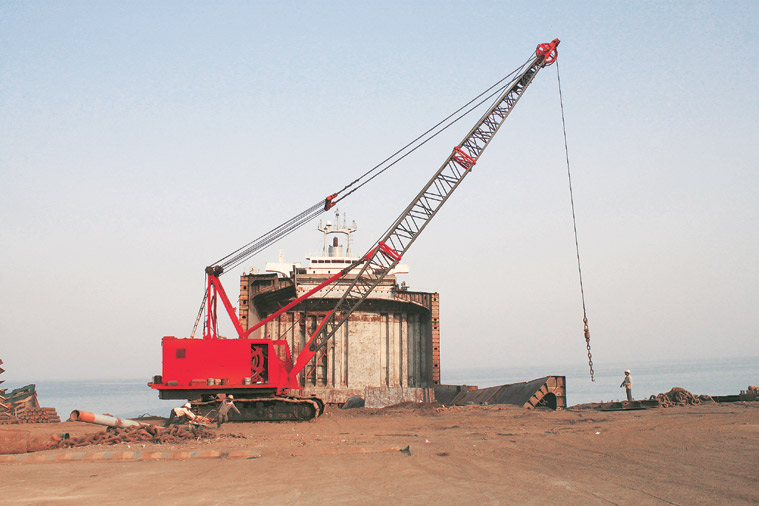
“With Chinese steel making its way into the Indian market, the prices have fallen. A tonne of scrap from Alang used to sell at Rs 27,000 last year. Today the prices are as low as Rs 18,000 for a tonne. The downturn in the infrastructure and construction sector, which used to be a major consumer of our steel, has also affected us. Thirdly, the devaluation of the rupee against the dollar makes it difficult for ship buyers to predict the payment price of the ship since the deal happens over several months. This has made business unviable. With losses mounting, shipbreakers have stopped purchasing ships,” says Rakesh Gupta, director of Priya Blue, a shipbreaking unit whose revenues have “been hit hard”.
The road that connects Alang to the nearby Sosiya village separates the
shipbreaking yards, all secured by iron gates and CCTV cameras, from the
workers’ quarters. The sound of sledge hammers on metal dulls as you move away
from the yards to the labour colony. The empty and abandoned shanties that line
the dingy lanes of this settlement tell the story of a dying industry.
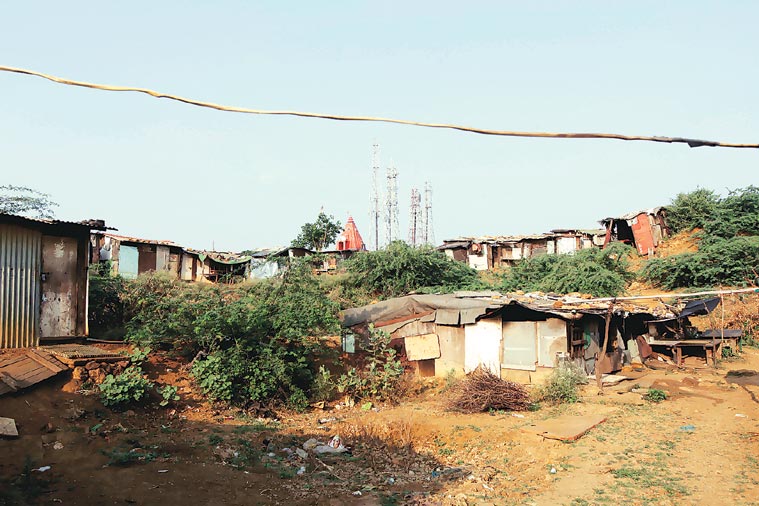
With a few minutes left for 7 am, Tara Singh, 35, a crane operator on one
of the plots, is rushing to get to work. His is from Chatra in Jharkhand and
has been in Alang for a few years now. But now, he fears he will end up like
many of his colleagues who have lost their jobs and returned home. His 10×10
feet hut is made of wood salvaged from ships, the roof is a thin metal sheet
weighed down by stones to prevent strong winds from blowing it away. Most
labourers sleep on wooden boards or pieces of discarded ship furniture. But
Singh is lucky to have retrieved a folding camp cot from a ship.
“Back in my village, I have three children, a wife and two old parents to
whom I send Rs 7,000 every month. I pay a rent of Rs 700 a month to the plot
owner for this shanty. The ship on our plot will take two more months to be
broken down. Once that gets over, I too will have to head home,” says Singh as
he quickly parts his wet hair with a comb, slips on a pair of shoes and rushes
to work.
By now, most of the workers have left for the yard. Ram Prakash Chauhan,
45, is among the few who haven’t left. “I lost my job,” he says. For the last
15 years, Chauhan has been working at Alang as a gas cutter. He will have to
soon leave for Gorakhpur, his home. “I started off earning Rs 40 a day. Today I
earn Rs 300. Yesterday, a few of us lost our jobs after we finished breaking
the ship on our plot. The owner said he wasn’t getting any new ships. For the
next three days, I will look for jobs in other plots. If I don’t find one, I
will go home. It has never been this bad here,” says Chauhan.
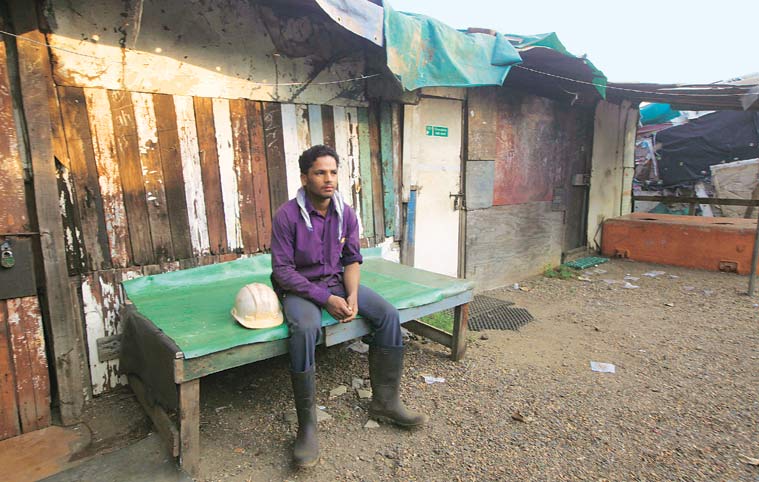
Alang’s labour-intensive industry drives the demand for unskilled and
semi-skilled workers from states such as Jharkhand, Bihar, Uttar Pradesh and
Odisha. The workers are almost all men who have left their wives and children
back in their villages. Though the working conditions are tough and even
hazardous – around 56 workers have died since 2010 in accidents, mainly from
fires on ships – for many, it’s the only way to keep their homes fires burning.
But that’s changing.
“Most of us are paid Rs 240 a day for eight hours of work. My earnings
used to easily cross Rs 300 with 6-7 hours of overtime. But now, with less
work, we hardly get to work overtime,” says 22-year-old Ranjan Goud, who came
to Alang a couple of years ago from Odisha in search of work.
“We used to have a workforce of 20,000. Now, hardly 5,000-6,000 people
work here. The slowdown in the industry began several months ago and the
effects are now showing,” says Chaddha of the Gujarat Maritime Board.
The Board, which manages and runs the basic infrastructure at Alang, is
building an organised labour colony for 1,000 workers. This “dormitory type of
colony”, says Chaddha, will be extended to accommodate 5,000 workers if the
pilot project is successful.
The Board has seen its revenues from Alang dip by 50 per cent – from the
Rs 36 crore that the body earned last fiscal to Rs 18 crore.
All is not lost, though. Some shipbreakers say that as the economy gets
back into shape, the usual buzz will return to Alang, sooner or later.
Gupta, the director of Priya Blue, believes that as long as there are
ships to be broken, Alang will remain relevant. He dismisses fears of
shipbreaking moving from Alang to other such yards, including the facility
proposed by the Adani Group, adjacent to its existing Mundra West Port in Kutch
district. “Mundra or any other spot in India cannot replace Alang. With a beach
that has a 15-degree slope and a high inter-tidal gradient, Alang has a natural
advantage. This enables large ships to come straight into the shore during high
tide and when the tide recedes, the ship stands on an almost dry dock.
Secondly, the beach is sandy and ship doesn’t sink into the mud,” he says.

Besides, Gupta says, Alang is geographically well-placed to carry
ship-breaking right though the year. With its 10-km-long coast facing the Gulf
of Khambhat, it is sheltered from high-velocity winds and heavy rainfall. In
contrast, other ship-breaking destinations such as Gaddani in Pakistan and
Chittagong in Bangladesh have strong winds and strong tides and therefore, can
only demolish very large vessels.
The road from Ahmedabad to Bhavnagar bifurcates near Trapaj village,
where a blue-and-white arch welcomes visitors to the Alang-Sosiya shipbreaking
yard. Winding its way through the village before opening into the ‘Alang
Bazaar’, rows of shops on either side that sell everything that the ships once
held.
Alang’s ship-breaking supports an entire ancillary industry of furniture,
knick-knacks and memorabilia that go by the brand ‘Alang’. Apart from the metal
scrap sold from the ships, these 350-odd shops sells ropes, inflatable
dinghies, beacons, foreign cosmetics, compasses, board games, paintings, wooden
furniture, crockery, cutlery, and even bathroom and bedroom furnishings,
dismantled from passenger and cargo ships.
Raju Baradiya, who runs his Amar Traders opposite Alang Police Station,
from where he sells different items salvaged from ships, says, “We used to have
at least 10 customers visiting us every week to buy items such as stainless
steel tables, ovens, storage cabinets, coffee makers and dish-washers. Now the
number of visitors has reduced to half, as fewer ships are coming to Alang.
Business has been affected.”
It’s definitely a big fall from 2008, when the 9,000-tonne American
casino liner, ‘Texas Treasure’, arrived in Alang. When the white luxury ship
beached on the Arabian Sea, shoppers made a beeline for the Alang shore. As the
Texas was broken down, typical casino ware such as slot machines and roulettes
lay strewn about the yard and stores and shoppers took home handsome wine
goblets, bars, and other trinkets that were otherwise prohibitive or
unavailable in Gujarat markets. Furniture bought from Alang is seen as “high
value”, given its weather-beaten wood and steel.
Ahmedabad-based Amit Panchal, a Gujarat High Court lawyer, calls himself
an “avid Alang shopper”. “I haven’t gone to the shipyard in the last 2-3 years.
But for 12 years before that, I would go to Alang regularly and buy crockery,
comforters, even safes,” he says.
In his office is a wooden coat hanger, a 3×6 metre tricolour flag and a
small brass model of a ship he bought for Rs 3,000 – some of the souvenirs he
holds on to for his “back in the days in Alang” moment.
Source: Indian express. 18 December
2015
No comments:
Post a Comment